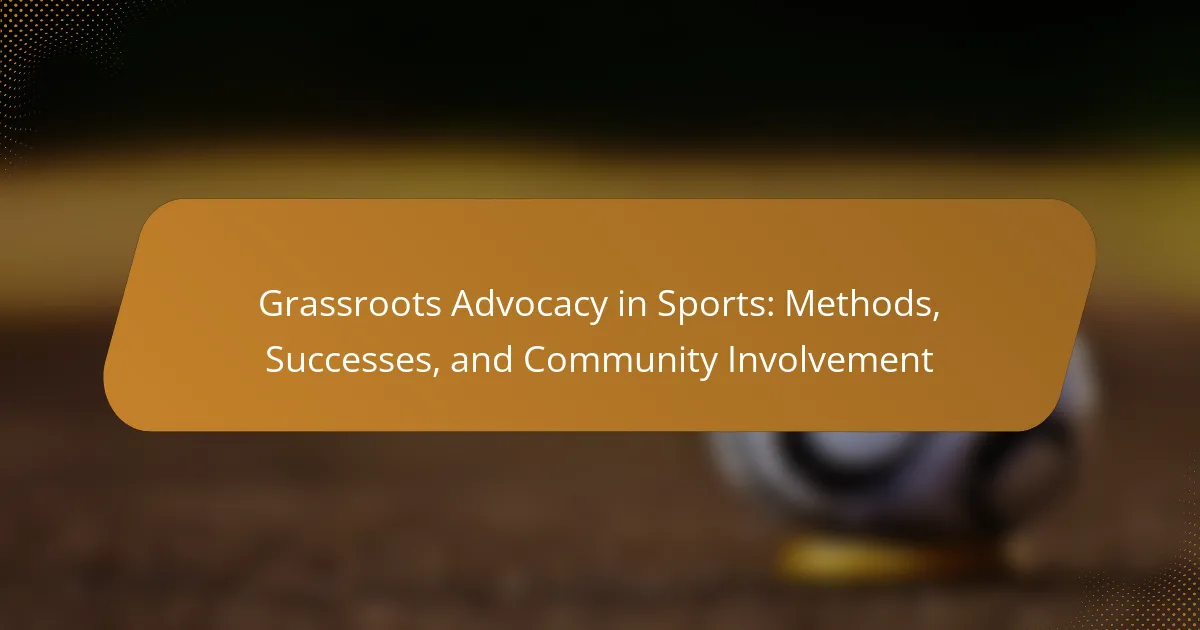Grassroots advocacy in sports empowers communities to drive change and enhance participation. This article explores effective methods like community engagement, social media campaigns, and coalition building. It highlights notable successes achieved through these strategies, including improved facilities and increased funding. Additionally, it examines the vital role of community involvement in fostering ownership and support for local sports initiatives.
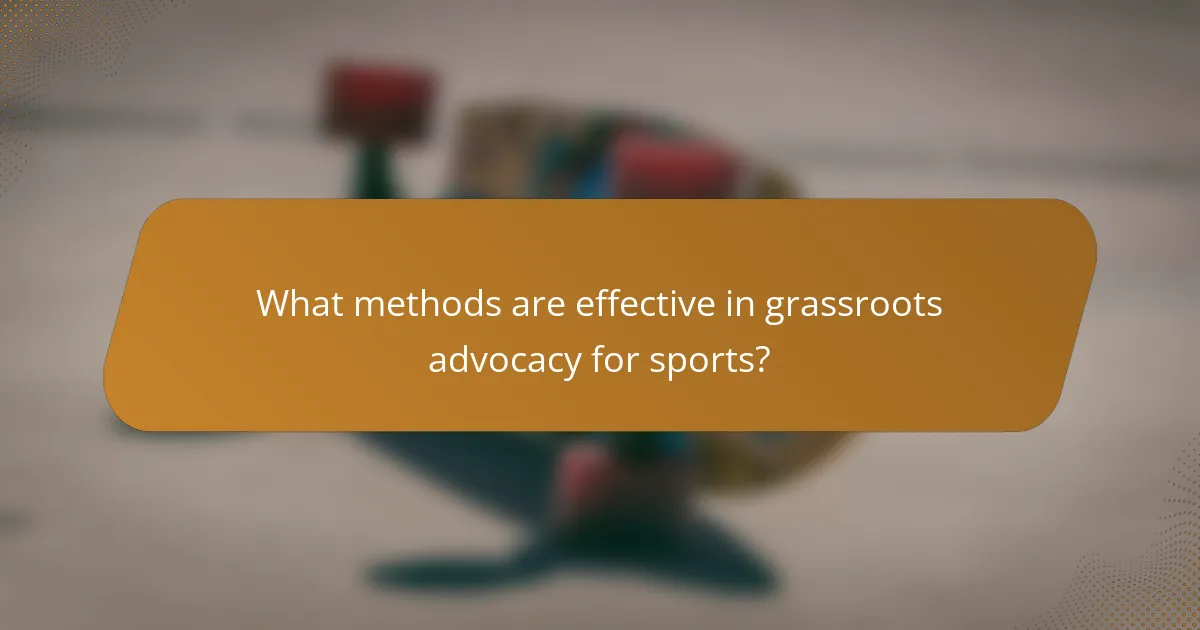
What methods are effective in grassroots advocacy for sports?
Grassroots advocacy in sports is effective through community engagement, social media campaigns, and coalition building. These methods foster local support and create a unified voice for change.
Community engagement involves organizing events and workshops that educate and mobilize supporters around specific sports initiatives. Social media campaigns leverage platforms to reach broader audiences, raise awareness, and encourage participation. Coalition building connects various stakeholders, including athletes, organizations, and fans, to amplify advocacy efforts.
Success in these methods often hinges on authentic storytelling and shared experiences, which resonate with the community. Engaging local influencers can also enhance credibility and outreach.
How can community engagement enhance advocacy efforts?
Community engagement significantly enhances advocacy efforts by fostering collaboration and mobilizing support. Engaged communities amplify voices, leading to increased visibility and impact. For instance, grassroots movements often leverage local networks to build momentum and influence policy changes. Successful campaigns demonstrate that when communities unite, they can effectively advocate for sports initiatives, driving meaningful change.
Which digital platforms support grassroots movements in sports?
Digital platforms that support grassroots movements in sports include social media, crowdfunding sites, and community forums. These platforms empower communities to organize, raise funds, and share their stories effectively.
Social media platforms like Facebook and Twitter allow grassroots movements to amplify their messages and engage with wider audiences. Crowdfunding sites such as GoFundMe enable financial support for local sports initiatives. Community forums foster discussions and collaboration among advocates.
These platforms enhance community involvement, driving participation and creating a sense of belonging in grassroots sports movements. They facilitate connections between like-minded individuals and organizations, ultimately contributing to the success of these initiatives.
What role do local organizations play in advocacy initiatives?
Local organizations are crucial in advocacy initiatives by mobilizing community support and resources. They facilitate grassroots movements, connect individuals with shared interests, and amplify local voices. Their engagement leads to increased awareness and action on sports-related issues. For example, local sports clubs often organize events that raise funds and promote causes. This community involvement fosters a sense of ownership and commitment, enhancing the effectiveness of advocacy efforts. Ultimately, local organizations serve as a bridge between the community and larger advocacy networks, ensuring that local needs are addressed in broader initiatives.
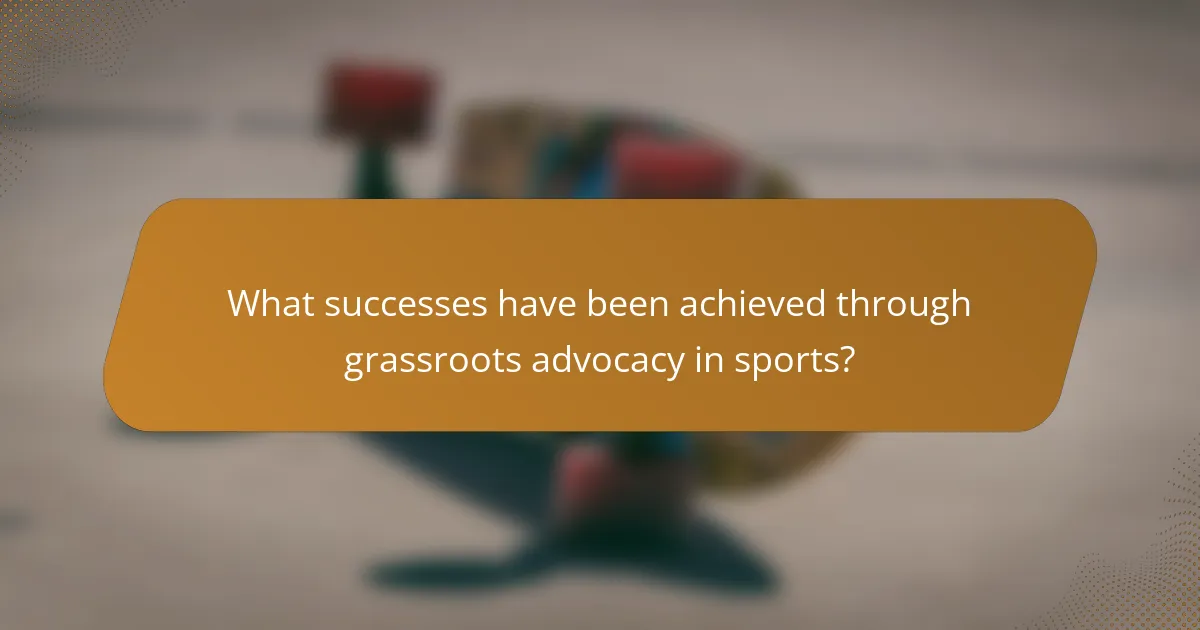
What successes have been achieved through grassroots advocacy in sports?
Grassroots advocacy in sports has achieved significant successes, including increased participation and funding. Community-driven initiatives have led to the establishment of youth sports programs, enhancing accessibility. For instance, local advocacy groups have successfully lobbied for better facilities, resulting in improved training environments. Additionally, these efforts have raised awareness about the importance of diversity in sports, fostering inclusive practices. Such grassroots movements empower communities to advocate for their needs and drive positive change within the sports landscape.
Which case studies highlight impactful grassroots campaigns?
Several case studies showcase impactful grassroots campaigns in sports, demonstrating community engagement and advocacy success. One notable example is the “Stop the Stadium” campaign in San Francisco, which united local residents against a proposed stadium project, emphasizing community voices and environmental concerns. Another case is the “Play Fair” campaign in the UK, which mobilized grassroots support to improve conditions for athletes, highlighting issues of equity and fair play. The “Youth Sports Alliance” in Los Angeles successfully advocated for increased funding for youth sports programs, showcasing the power of community involvement. These campaigns illustrate how grassroots advocacy can influence policy and promote social change in sports.
How have grassroots initiatives influenced policy changes in sports?
Grassroots initiatives have significantly influenced policy changes in sports by mobilizing community support and advocating for equitable practices. These movements often highlight local issues, leading to increased awareness and pressure on policymakers. For example, initiatives aimed at increasing youth access to sports have resulted in funding changes and new programs at the municipal level. Additionally, grassroots advocacy has successfully pushed for policy reforms addressing inclusivity and diversity in sports organizations. As a result, these efforts not only reshape policies but also foster a sense of community engagement and empowerment within the sports sector.
What metrics indicate the success of grassroots advocacy efforts?
Metrics indicating the success of grassroots advocacy efforts include community engagement, policy changes, and measurable outcomes. Community engagement can be assessed through participation rates in events and social media interactions. Policy changes reflect the effectiveness of advocacy, marked by new legislation or amendments. Measurable outcomes include improvements in local sports programs, increased funding, or enhanced public awareness. These metrics collectively demonstrate the impact and effectiveness of grassroots advocacy in sports.
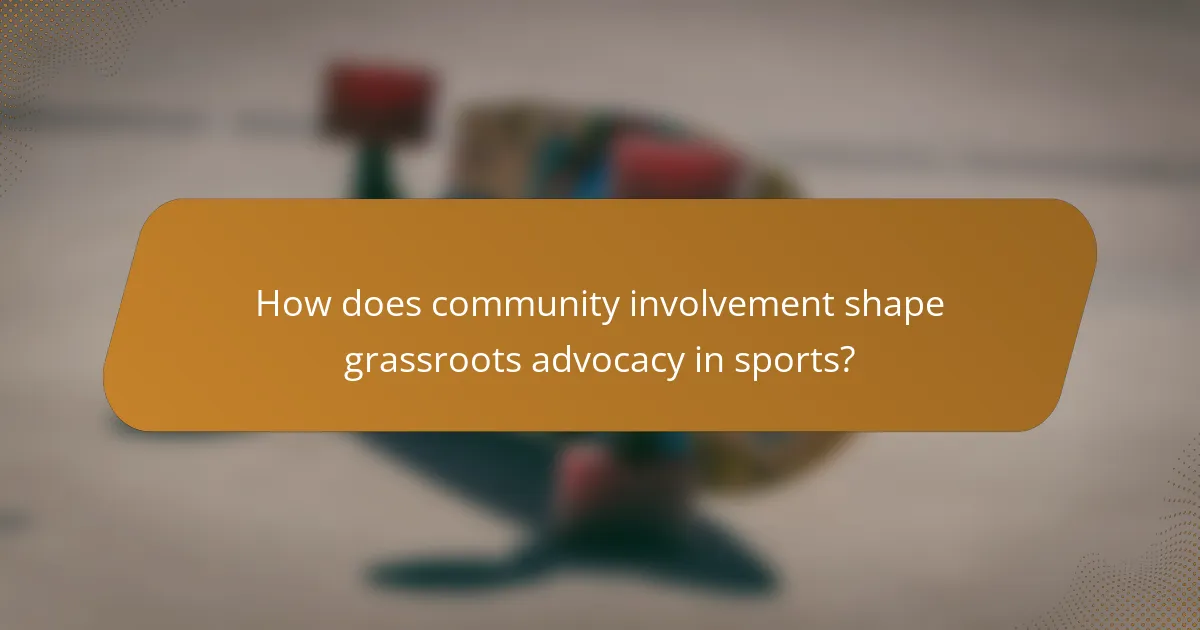
How does community involvement shape grassroots advocacy in sports?
Community involvement significantly enhances grassroots advocacy in sports by fostering local engagement and support. It empowers individuals to participate actively, leading to increased awareness and resources. Strong community ties create a sense of ownership, motivating collective action for local sports initiatives. Collaborative efforts often result in successful campaigns that address specific community needs, demonstrating the unique attribute of grassroots movements. Engaged communities can mobilize quickly, responding to challenges and opportunities effectively.
What are the benefits of volunteer participation in advocacy campaigns?
Volunteer participation in advocacy campaigns enhances community engagement, raises awareness, and drives policy change. Participants gain valuable skills, build networks, and foster a sense of belonging. These benefits empower individuals and strengthen grassroots movements in sports. Additionally, volunteers contribute unique perspectives that enrich campaign strategies, making them more effective and inclusive. As a result, advocacy efforts become more representative of community needs and values.
How can diverse communities be included in sports advocacy?
Diverse communities can be included in sports advocacy through targeted outreach, representation, and collaboration. Engaging local leaders fosters trust and ensures that advocacy efforts reflect community needs. Additionally, creating inclusive programs that cater to various cultural backgrounds enhances participation and support. Successful initiatives often incorporate feedback from community members to adapt strategies effectively.
What challenges do communities face in grassroots organizing?
Communities face several challenges in grassroots organizing, including limited resources, lack of awareness, and internal conflicts. These obstacles hinder effective advocacy and community engagement. Limited funding restricts outreach and program development. Lack of awareness about issues can lead to insufficient participation. Internal conflicts may arise from differing priorities, which can fragment efforts and dilute impact. Overcoming these challenges requires strategic planning and strong leadership.

What unique attributes distinguish successful grassroots advocacy campaigns?
Successful grassroots advocacy campaigns are distinguished by their community engagement, clear messaging, and adaptability. These campaigns often leverage local networks to mobilize support and create a strong sense of ownership among participants.
Unique attributes include the ability to foster personal connections and utilize storytelling to resonate with diverse audiences. Successful campaigns often employ strategic partnerships with local organizations, enhancing credibility and resource sharing.
Moreover, they typically adapt their strategies based on real-time feedback, ensuring relevance and responsiveness to community needs. This flexibility allows them to navigate challenges effectively, leading to sustained momentum and impact.
How do cultural factors influence advocacy strategies in sports?
Cultural factors significantly shape advocacy strategies in sports by influencing community engagement and messaging. For instance, regional values determine how local teams are supported. Cultural narratives can enhance grassroots movements, fostering unity among diverse groups. Understanding these dynamics allows advocates to tailor approaches that resonate with specific demographics, ultimately increasing participation and support.
What innovative approaches have emerged in grassroots sports advocacy?
Innovative approaches in grassroots sports advocacy include community engagement, digital platforms, and collaborative partnerships. These methods empower local voices, increase visibility, and foster inclusive environments. For example, social media campaigns have successfully mobilized support for underrepresented sports, enhancing community involvement. Additionally, partnerships with schools and local organizations have led to increased participation and resources for grassroots initiatives.
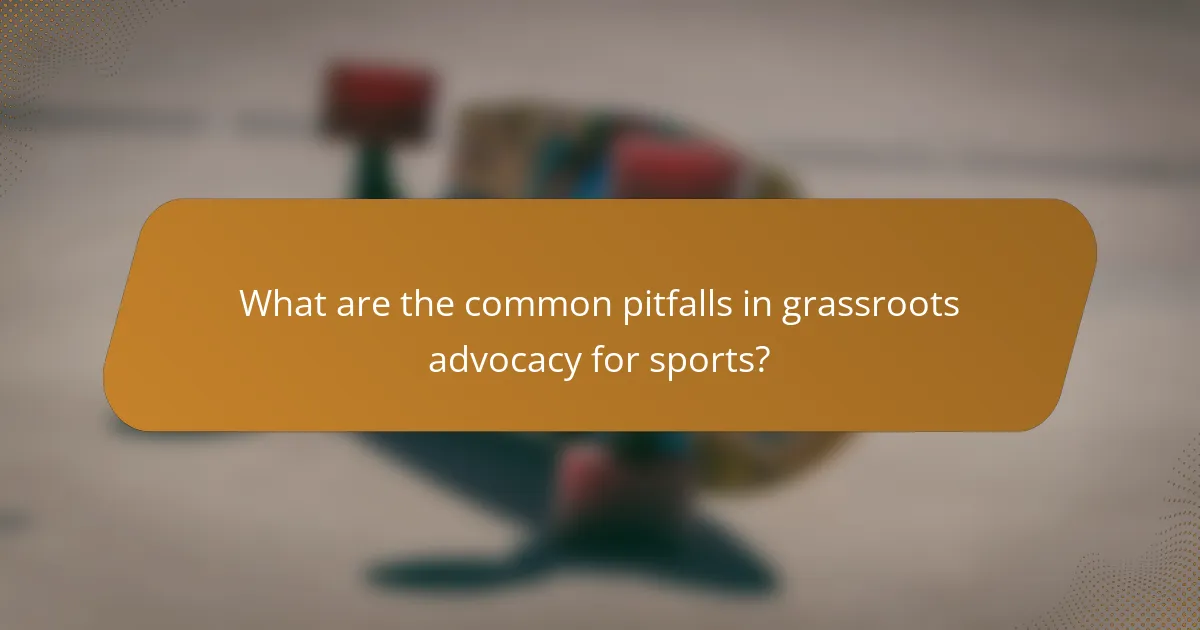
What are the common pitfalls in grassroots advocacy for sports?
Common pitfalls in grassroots advocacy for sports include lack of clear goals, insufficient community engagement, inadequate funding, and poor communication strategies. These issues can hinder the effectiveness of advocacy efforts.
1. Lack of Clear Goals: Without specific objectives, initiatives may lack direction and focus.
2. Insufficient Community Engagement: Failing to involve local stakeholders can lead to disinterest and reduced support.
3. Inadequate Funding: Limited financial resources can restrict outreach and program development.
4. Poor Communication Strategies: Ineffective messaging can fail to resonate with the target audience, diminishing impact.
What mistakes should advocates avoid when mobilizing communities?
Advocates should avoid miscommunication, lack of inclusivity, and insufficient research when mobilizing communities. Miscommunication can alienate potential supporters and create confusion. Inclusivity ensures diverse voices are represented, fostering stronger community ties. Insufficient research leads to ineffective strategies that do not address community needs. Prioritizing clear messaging, community engagement, and data-driven approaches enhances grassroots advocacy efforts in sports.
How can advocates ensure sustainability in their initiatives?
Advocates can ensure sustainability in their initiatives by fostering community engagement, securing diverse funding sources, and implementing long-term strategies. Engaging the community builds ownership and commitment, while diverse funding mitigates financial risks. Long-term strategies, such as regular impact assessments, adapt initiatives to changing needs, ensuring relevance and effectiveness.

What best practices can enhance grassroots advocacy efforts in sports?
Grassroots advocacy in sports can be enhanced through community engagement, strategic partnerships, and effective communication. Building relationships with local organizations fosters trust and support. Utilizing social media platforms amplifies messages and mobilizes volunteers. Training advocates on advocacy techniques empowers them to influence policy effectively. Engaging diverse community members ensures representation and strengthens efforts.
How can advocates leverage partnerships for greater impact?
Advocates can leverage partnerships to amplify their advocacy efforts and achieve greater impact. Strategic collaborations with local organizations, businesses, and community leaders enhance resource sharing and expand outreach. These partnerships can also provide access to diverse networks, increasing the visibility of advocacy initiatives. For example, a grassroots sports advocacy group might partner with schools to promote youth engagement in sports, thereby fostering a healthier community. Engaging in joint events or campaigns can also unify voices, leading to more substantial influence on policy changes.
What strategies promote effective communication in advocacy campaigns?
Effective communication in advocacy campaigns relies on clear messaging, active listening, and community engagement. Utilize storytelling to connect emotionally with the audience. Foster collaboration among stakeholders to amplify voices. Leverage social media for outreach and real-time feedback. Implement training sessions to equip advocates with communication skills.
How can grassroots advocates measure and report their impact?
Grassroots advocates can measure and report their impact through surveys, community feedback, and participation metrics. These methods provide quantitative and qualitative data on engagement and success. For example, tracking the number of participants in events or initiatives can highlight community involvement. Additionally, sharing success stories and testimonials can effectively communicate the advocacy’s influence on the community. Regular reporting fosters transparency and encourages continued support.
